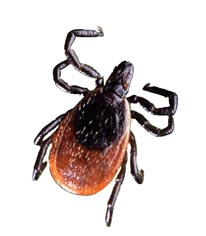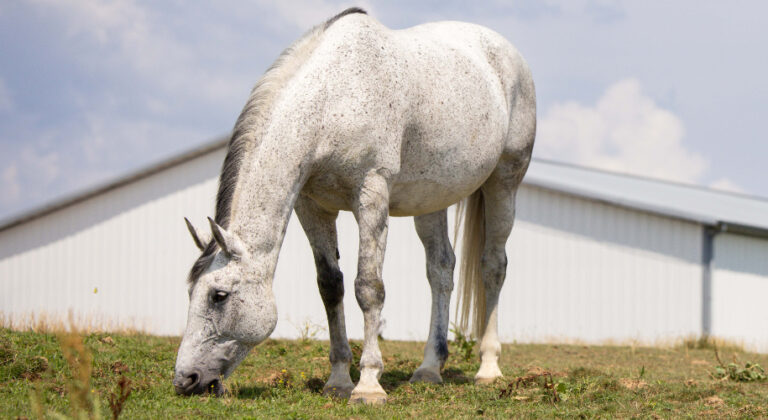The problems started with stiffness in your horse’s right hock. Now the hock seems better, but he’s off in front. And he’s definitely not his normal, perky self—he mopes around in his paddock, and he pins his ears and tries to move away when you groom him.

On-again, off-again lameness, low energy levels, a cranky attitude—those signs could point to something as simple as overwork. But Lyme disease could produce all those problems, and it may be a growing problem for horses in parts of the United States. Lyme disease can have long-term complications that include damage to your horse’s joints, skin, nervous system and even vision.
A bacterial disease spread by tick bites, Lyme is a problem for people, dogs and other animals, not just horses. As the ticks that carry this disease slowly expand their range, cases and concern are increasing. Is your horse at risk? If he develops Lyme disease, how will you know, and what should you do? Can you protect him? This article will help you make sense of the threat.
Who’s at Risk?
Lyme disease takes its name from Lyme, Connecticut, where it was first identified in the 1970s. It’s now the most common vector-borne disease in the United States, according to the US Centers for Disease Control, which tracks human cases. The disease has popped up in almost every state, but CDC figures show that most cases occur in the northeastern, mid-Atlantic and north-central states, with pockets in Pacific and southern states.
While no one collects national statistics on Lyme disease in horses, cases tend to occur in the same areas as human cases, says Thomas J. Divers, DVM, of the Cornell University School of Veterinary Medicine. Those are all places where the disease-carrying blacklegged ticks—mainly deer ticks and Western blacklegged ticks are common. In some areas up to half the blacklegged tick population may harbor the spiral-shaped bacteria, Borrelia burgdorferi (Bb), that cause Lyme disease.
The ticks have three life stages (larva, nymph and adult) and need a blood meal before they can molt into the next stage.
They pick up the bacteria as larvae and nymphs by feeding on the blood of infected mice, and they transmit the infection to their next hosts—human, horse, dog, deer or any passing mammal or bird. They seem most likely to feed on horses as adults. In cold-winter regions, adults typically appear in early fall, spend the winter dormant in brush and leaf litter and come out again in early spring. This makes early spring and fall prime times for infection. But horses can get Lyme disease whenever infected ticks are active.
CDC statistics show a steady increase in reported cases. In some areas, including parts of Maryland and Virginia and northern New England, human case numbers are up sharply. Maine, for example, went from no cases reported in 1988 to 970 in 2009. Maine state veterinarian Don Hoenig, VMD, says that Lyme disease is turning up in new areas as the vectors—deer ticks—increase their geographic distribution. “We have ticks where we had none six or seven years ago,” he says. Several factors likely contribute to the spread:
- Wildlife populations: Deer and other wildlife hosts, including migratory birds, can carry the ticks and move them to new areas.
- Changing landscapes: In many areas abandoned farmland is reverting to forest, and the ticks prefer forest habitat to fields. They’re often found in the brush of the forest understory and forest edge and suburban yards, which mimic that habitat.
- Warming climate: Warmer winters allow ticks to expand their range northward and to spread disease for more of the year, as they are active whenever the temperature is above 40 F.
Reports of Lyme disease have also increased as people have become more aware of it. “We’re looking for it more,” Dr. Hoenig says. Lyme is now so prevalent in Maine, he adds, that it’s no longer on the state department of agriculture’s list of reportable diseases.
If your horse is in a region where blacklegged ticks live, he’s at risk. But even if he’s bitten, he may not get sick. Even if a tick is packing the bacteria, it generally must attach and feed for more than 24 hours before it transmits the infection to its new host. And even when a horse is infected, he may not develop any signs of the disease. “There must be a distinction between infection and disease,” says Dr. Divers. Infection is common where the disease-carrying ticks are prevalent—nearly half of adult horses in some areas of the Northeast have been infected. “Clinical disease [disease that produces recognizable signs] does not appear to be common in horses, although we do not have data on this,” he says.
Is It Lyme?
Early diagnosis is the key to preventing the most serious effects of Lyme disease, but that’s easier said than done. A few years ago, after fielding numerous phone calls about Lyme disease, Dr. Divers and colleagues at Cornell decided to investigate the disease. They experimentally infected a group of ponies to study the effects on blood and body tissues, and they evaluated treatments and a potential vaccine.
“It’s difficult to prove Lyme disease,” says Dr. Divers. You may never see the tick that bit your horse; the ticks generally drop off after feeding. Signs of disease often don’t emerge for five to six weeks after the bite, and the signs vary widely and are notoriously vague. Three common ones are
- stiffness in large working joints (fetlock, knee, elbow, hock or stifle, for example). Lameness that’s sporadic, affects multiple sites or shifts from limb to limb is characteristic. The cause of the clinical signs is polysynovitis, inflammation in the membranes that enclose these joints, Dr. Divers says.
- generalized tenderness or sensitivity your horse flinches, perhaps, when you curry him, or seems to overreact to other sensory stimuli. This condition, called hyperesthesia, results from inflammation in the skin and nearby nerves.
- behavioral changes, such as unwillingness to work and a depressed or irritable attitude.
You may see other signs low energy levels, low-grade fever, joint swelling, a sore back. Often early signs fade, and they may never return. But persistent Lyme disease has been linked to weight loss, chronically stiff and swollen joints, neurological problems and inflammation of the eye. Some of the damage may stem from the immune response the horse mounts against the infection, rather than from the bacteria themselves.
Where the disease is common, worry about it sometimes leads horse owners to think “Lyme” at the first sign of trouble. Dr. Divers says it’s essential to rule out other possible causes overwork, injuries, other diseases that can produce similar signs. For this, your veterinarian will start with a thorough exam and a review of your horse’s history. If the results suggest Lyme disease, the next step is to confirm, through blood tests, that your horse has been infected with Bb bacteria.
The most widely used tests look for antibodies produced as part of the horse’s immune response to the bacteria. The horse doesn’t produce these antibodies immediately, so false negative results are possible if tests are run soon after infection.
The Snap 3Dx is a quick screening test. It detects antibodies and provides an instant result without requiring a lab.
A laboratory ELISA (enzyme-linked immunosorbent assay) provides a quantitative measure of antibodies. High levels (200-300 units and above) suggest infection. But antibodies may continue to circulate in blood long after the bacteria are gone, so a low or even a high level may just mean that your horse was exposed to Bb at some point in the past.
A Western blot detects antibodies produced against specific proteins of the Bb bacteria. It’s more sensitive than the ELISA, which doesn’t always discriminate well between antibodies to Bb and certain other organisms. Veterinarians often order this test to confirm a positive ELISA.
Diagnosing Lyme disease can be tricky while blood tests can help make the diagnosis, often they don’t yield a clear answer. But if the physical exam and the tests both point to the disease, your vet may recommend that your horse be treated for it.
Treatment
When Lyme disease is recognized and treated early, the outlook for recovery is good. Most cases respond to antibiotics. “Tetracycline and doxycycline are recommended treatments,” says Dr. Divers. In the Cornell studies, intravenous tetracycline appeared to outperform oral doxycycline and another drug, ceftiofur, given by intramuscular injection, in eliminating the bacteria. But IV treatment often means that the horse must stay at a clinic, which can be expensive; so many veterinarians prescribe oral doxycycline and recommend IV tetracycline for those horses who don’t respond or relapse after treatment. Your vet may also suggest an anti-inflammatory such as flunixin meglumine (Banamine) or phenylbutazone to ease discomfort.
Most horses show improvement within days of starting antibiotics, but that doesn’t mean the bacteria are gone. Treatment generally continues for 30 days. The longer it goes untreated, the greater the risk that its effects will linger. Tissue damage in joints and other areas, whether caused by the bacteria or the inflammation that results from the disease, can be lasting.
Prevention
There is no approved vaccine against Lyme disease for horses. In the Cornell studies, an experimental vaccine successfully prevented infection in research ponies not previously exposed to the disease. But the process of gaining approval for a new vaccine is long and costly, and currently there’s no effort to bring an approved equine vaccine to market. The limited geographic distribution of the disease and questions about its clinical importance make an approved equine vaccine unlikely, Dr. Divers says.
For now, the best way to protect your horse is to limit his exposure to the ticks that carry the Bb bacteria. If you live where Lyme disease is prevalent
- apply fly repellents that contain permethrins. These insecticides are effective against ticks as well as flies, so the repellents will help discourage ticks from attaching to your horse. Be sure to use the repellents in fall and early spring, times when adult ticks are active even though flies may not be a major problem.
- give your horse a thorough daily grooming, paying special attention to the base of his mane and tail and around his ears, throatlatch and belly. Blacklegged ticks are so small that they’re really hard to find, but rigorous grooming may help keep them from hiding out in these areas. If you find a tick, use tweezers to grasp it right at the skin, where its mouthparts are embedded, and pull gently up.
- make your horse’s turnout space unfriendly to ticks. Tall grass, brush and overhanging branches make great tick habitats; the little pests can crawl to the tips of leaves and branches and latch onto your horse as he brushes past. If you mow the grass, cut the brush and trim the branches, you’ll have fewer ticks to worry about.
The CDC (www.cdc.gov/ncidod/dvbid/lyme/) and the American Lyme Disease Foundation (www.aldf.com/lyme.shtml) have tips and information that can help you and your horse avoid this disease.
More Tick Trouble
The same blacklegged ticks that spread Lyme disease may transmit another bacterial infection to your horse: equine granulocytic anaplasmosis (or ehrlichiosis). Classic signs include
- fever, often high (103-104 F) for the first one to three days
- depression and lethargy
- loss of appetite
- reluctance to move
- edema (stocking up or swelling in the lower legs).
Bacteria called Anaplasma phagocytophila (formerly Ehrlichia equi) cause this disease. It’s seasonal—the risk is greatest when ticks are active. In the United States many cases have been reported in California, where Western blacklegged ticks are the carriers; but it also turns up in northeastern, mid-Atlantic, and north-central states where deer ticks abound.
The bacteria attack white blood cells called granulocytes. Signs usually appear a week or two after a tick has fed on the horse, and they tend to be more severe in older horses. Sometimes the horse develops a yellowish tinge in the whites of his eyes or tiny red spots (petechial hemorrhages) in the mucous membranes. Occasionally there are neurological complications. Blood tests can confirm the infection. A PCR (polymerase chain reaction) test detects segments of the bacteria’s DNA; other tests check for levels of antibodies produced to fight the infection.
The same antibiotics used to fight Lyme disease—IV tetracycline and oral doxycycline—also work against anaplasmosis, without the need for prolonged treatment. Once treatment begins, horses usually recover promptly with no lingering effects and they seem to develop a natural immunity that protects them from this disease for up to two years.
This article originally appeared in the September 2010 issue of Practical Horseman magazine.








